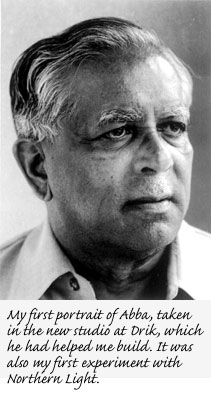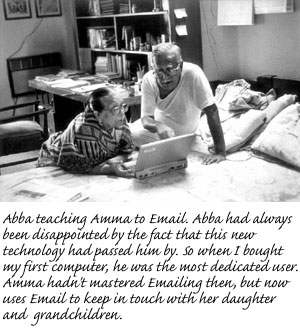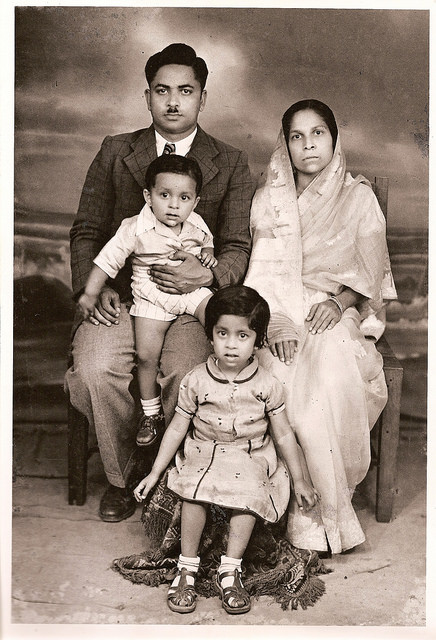
When A Pixel Paints A Thousand WordsI remember my fascination with Charles Babbage's machine, and my inward fear when first given the chance to use a computer. Logging in to the VAX was a great thrill, but that was the day of punch cards, and writing programs for everything. Learning was a slow process. A young kid told me of a program he had written. It was a simple program in basic that merely printed on the screen "This is my first program," but I was impressed. Boolean numbers were the next marvel. Soon I was changing things, making things happen. I worked with computer models. Intermediate structures of molecules I was synthesising in a chemical laboratory. A Tektronix monitor allowed me to see the shapes of the nucleotide rings that I worked with. I stretched bonds, distorted angles, looked for conformations of low and high stress. Almost listening to my molecules scream as I bent them into painful configurations. Watching them relax as I discovered the lowest energy states.
The printout churned out numbers, hundreds of them. These were what I needed for my quantification. Figures that I could translate into bond energies for transition states, numbers my examiners would understand. What fascinated me was that by changing numbers I could look at my molecules differently. I would change the window size, the azimuth angles, rotate them, look at them from above and below. I was like a little child with a giant model hovering above me that I could twist and turn at the press of a button. The computer and I had made friends.
I remember the excitement my father had when I bought my first computer. He had been a scientist all his life, but had to adopt an administrative role to achieve much of what he had done. He was an artisan who had wanted to work with his hands and his mind and sad that much of modern technology was passing him by. He was like a child in front of the machine. We watched together in amazement as the printer rattled out text noisily. I remember coaxing my partner Rahnuma into trying out the computer. She was convinced "the computer would bite." I remember sharing her deep sorrow when all her work got accidentally deleted. I remember the joy of adventure as the technician searched the disc for disjointed bits of information, trying to make a patchwork file out of her lost data. I remember feeling sad when my first motherboard died.
I got my video digitiser as compensation from someone who had lost one of my books. My friends and I couldn't get it to work, but the thought of animated images being created and manipulated in the computer and then transferred to video, got our imagination soaring. The next major event was my friend buying a hand held scanner. Soon I had bought one, and the next few weeks were merrily spent dithering, sharpening, solarising. I tried, without too much success, repeating some of the things I had done in the darkroom. My excitement had been blunted. Though there was the joy in discovery, I was expecting too much. The first darkroom I had worked in was cold, Spartan, and very large. I remember dancing in the room when the first black and white print emerged. I still feel that tingling joy when the first shadow details begin to emerge on the wet paper glistening in the red muted safelight. The computer image forms section by section, each bit complete and unchanging as the whole forms. I miss seeing it happen, breathing on the developer, rubbing furiously to darken a hot spot, willing the print on when the blacks aren't rich enough. Perhaps there is something about that slow process of making masks, the uncertainty of the outcome, the sheer joy of seeing a full range of shimmering tones that will never be replaced. But curiously, with so many tools at ones disposal on the desktop, it is as if my imagination and not my tools which is the limiting factor.
When I teach about colour, I tell people to close their eyes and think of a colour they have never seen. Neither I nor they have ever succeeded. We are so limited by our experiences. I believe that is what we should try and overcome. All these tools are darkroom based. Things people have done mechanically in some form or other.
What I would like to do is to be able to visualise what I have never experienced. Not some darkroom trick made easy, not yet another combination from a million and a half palettes. I would like to see the world as I might after I was dead. Or perhaps through the eyes of a giant caterpillar, with its UV vision and its huge towering compound eyes. I would like to see as a lover sees through joyous and tear streamed filters.
Digitising things is in a way like breaking things that we know and perceive — elephants, numbers, colours, sounds, loved ones — into elemental particles that are within the group identical, sexless, classes, and nondescript, surviving almost as conceptual entities. Our universe defined as electrons, mesons, pions. These characterless wave particles, by virtue of their collective structure, make up blades of grass, Einstein's and Mohammed's, shafts of lightning, our thought processes. In digitising words, numbers, graphic, sounds, colours, we convert all these objects of our perception to strings of 0s and 1s. The ultimate deconstruction. A scream, an iridescent hue, an irrational number, all translate to 0s and 1s.
Is that the goal of technology? The search for the ultimate truth? The oneness we so long to find? Is that what our genes perpetuate — 0's and 1's? What a let down for our romantic dreams. What a wonderful discovery. What staggering simplicity. Just two building blocks, a zero and a one.
Sitting at my terminal I feel the cool breeze of the monsoon afternoon, heavy with the sweet scent of ripe mangoes. A crow calls from the coconut tree, the call fighting for recognition amidst the ever rising clamour of the construction workers building yet another sky scraper. The soft cold light from the textureless grey sky bounces gently from the green leaves. The keyboard makes a quiet clatter as my cursor moves across the screen. WYSIWYG. Is this reality? Or has David Hume's immateriality found a new meaning. There is no you or I, or the universe or God, just 0s and 1s.
I print my pictures full frame. In a way exercising a certain discipline upon myself to be rigorous about what I include, and exclude. In a way to accept the accidents that take place, the elbow in the corner, the dismembered torso, the blur of a passing stranger, the obstruction of a carelessly outstretched limb, the bit we didn't really want to show. The certain grace of serendipity that is difficult to replicate. I shoot on roll film, and therefore do not have the preconceived notions of zones, that my fine art colleagues espouse, I do not give N- 1 development and N+ 2 exposure, unless it is for the whole shebang.
I am easily seduced by the dark rich tones of a juicy print. I like my catch lights clean and sparkling highlights with a hint of texture. I like subtle detail in my shadows. I try to capture what is and create what isn't. In no way do I attempt to simulate "what there was." The myth of objective perception never moved me.
My print is at least as much a product of my values, my desires, my moods, my ability , as it is of the physical entity that gave rise to it, and I have never been ashamed of it.
So what is this representation of reality, this myth that a photograph never lies? A photograph is a tool like any other, used in whatever way its user intends, to achieve whatever end by whatever means. The faded portrait in a dying soldier's wallet is part of the reality created by him and him and us who have sent him to war. So what if the person no longer loves him, so what if he is scorned for what he does? That reality gives him courage, strength, endurance. Helps him kill others with equally faded photographs.
Wide angle b/w shots, grainy, high contrast, huge billboards with a dying malnourished child in a corner with outstretched arms. A clear message in polished bold font in the top left corner cleverly left blank. The message reads "We shall always be there." A reality constructed for and by those who want us to forget the implications. That " you shall always be there". In that role, a passive existence necessary to maintain, to nurture, the act of giving, forever and ever. A reality perpetuated and propagated, till it becomes history. Till it becomes truth. Amen.
What of the other reality? The one about how she became the way she is? The one about the outstretched arm that takes back much more than it gives? It is a reality denied.
Advertising campaigns and fund raising events forget to tell you that when you sponsor a child, you largely sponsor the players in one of the best run businesses, one called development.
Perhaps the child wasn't sad enough. The tear large enough, the halo on the giver bright enough. We now have the power. They were almost catching you with the old technology. Even though we designed things that had to be used and stored in cool dry conditions. Even though cameras cost the same as a hundred bags of rice, they were catching up. They were making statements, asking questions, interfering with reality. They will need a million bags of rice for CD ROMS and high end scanners. Our new reality is safe.
Perhaps it is all for the better. In time we will accept that pictures are the product of those who produce them and do tell lies, as do people generally. Perhaps in a more mature world wars will not be won or lost, by the media. Perhaps we will be perceptive enough not to be led into a war that has always been present. Perhaps like Jonathan Livingston Seagull, we will really learn to fly. Like Maxwell's Demon we will tame the pixels and teach them to dance.
But for any of this to happen, this digital revolution must reach out to those who have always been denied. We must dance in unison.
While we unleash this flood of energy, this joy of numbers that can let our imagination wantonly soar, it must not be inaccessible to those whose reality we have always suppressed. Our gigabits and superchips must not widen the chasm that a monopolised technology already maintains. But if this was to be the way in which a little child in a village school was only a modem away. An affordable modem, like chalk and slate (still unaffordable to many). If we could paint together in a universal bulletin board. If the digital chorus included the boatman's song. If the dance of pixels syncopated with distant drumbeats. Then, surely, in a world where numbers obeyed no borders and vision was the only barrier to creativity. The new reality world belongs not only to the owners of silicon valley but to the child on the billboard.
I choose my format, use my favourite film, decide carefully on the texture of paper, without once realising that my "freedom" has always been defined by the multinationals who treat me as yet another number. Maybe I am not included in their numbers game. They publish literature that goes from 18° C to 24° C. My room temperature never goes down to 26°, but I am a buyer, and therefore I belong.
Today there is a new found freedom. I can create my own film, use Kodachrome or Fuji chrome, or the now extinct GAF 500, even my own customised brand, with a colour bias peculiar to my own taste. By changing the dot size, I simulate large format or 110 (I am already having troubled thinking outside the known formats).
Fancy software can change my perspective or magnification at will. I have Nikon's latest super lens in my armoury and even ones they haven't made.
From anamorphic lenses to ones with controlled barrel distortion, everything is in my reach. I can make pictures fuzzy, sharpen fuzzy ones. Mama take my microchip away.
It is no longer difficult to make intense highlights coexist with subtle shadow detail with ever expanding grey scales. But wasn't it the lack of grey that made Newman's portrait of Stravinsky, or Brassai's "Big Albert's Gang?" Photography's inability to retain an extreme range of tones used majestically to carve out sculptures of light in space. Surely this new technology will not tame a Newman or a Brassai. It will create new ones. The new magi, who will probe and tease, taking it to new visual heights, will ride the mighty pixel. Jerry Ullsmann's hypnotic seamless images will no longer need a master craftsman, just an Ullsmann's vision. What a test of visual puberty!
No longer will I hide my hand. My style, my approach, my visual signature will be for me to create, unfettered by manufacturers whims or market decree. What about the fight we had almost won? The one about ownership of negatives, of editorial control. Perhaps it is time to shun the obvious, the mad rush for greater circulation, the megabucks. Perhaps it is time for photographers to be their own editors.
With desktop publishing and laser printers, or even downloading page made material to high street up-market scanners, to obtain total editorial control.
A co-operative that could work as it had originally been intended, where photographs were made collectively. As for accuracy, it was always a misnomer, one's observation is always culture and context sensitive, and the photographer is no exception.
What of the photograph made out of nothing? What about painting with light? Is it photography? Surely if we can paint with light we can paint with dreams, create the morning mist or the afternoon glow. Is it a fake? Hardly. Whatever else may be false in this tenuous existence of ours, imagination is not. All that we value, that we strive to uphold, all that gives us strength, has been made of dreams, and we must dream on. If pixels be the vehicle that realises our dreams, be it so.
Perhaps the digital image will democratise photography. So many bytes per pound of flesh. Perhaps there will come a time when CD ROM costs a dollar a piece, and palm tops have gigabits of RAM. Perhaps with e-mail and electronic bulletin boards, points of view that could never before be heard will whisper in many ears, ever louder. Maybe, on the other hand, the digital revolution will create rifts within the third world itself, and limited access to an exclusive technology will widen gaps within poorer countries.
Perhaps wealth will have a greater bearing on a photographer's output than ever before.
It will no longer be the best camera and the fastest lens, but the biggest RAM and the finest peripherals which will decide. The poor will get poorer.
Perhaps that is the end result of democracy, an equality of opportunity that creates the opportunity of greater rifts. Will that rift in art, despite the natural processes of osmosis, lead to greater imbalance in society at large? Art does not have a conscience. Achievement is an end in itself that pushes it to ever extending limits. But this heightened sense of power, this endless opportunity, will need to grow a separate consciousness that will question the validity of our actions. And there is no going back. Like those Brazilian kids on the speeding trains, we must just hang on the roof, dodging the wires as best as we can, hurtling ever forward till the train stops, and just hope we are in the right station.





